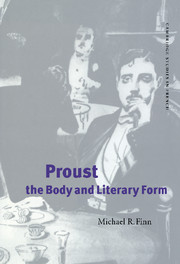1 - Proust between neurasthenia and hysteria
Published online by Cambridge University Press: 05 November 2009
Summary
Studies of hysteria, as a socio-cultural phenomenon, as medical fact and myth, and as a subject for literature, represent a burgeoning field that is both important and, as Mark Micale has put it in a recent and readable overview, ‘hopelessly’ fashionable'. The medicalization of human experience – and particularly of female experience – in the literature of the second half of the nineteenth century has attracted a major subset of these new hysteria studies.
As we now know, although French interest in hysteria peaked during Jean-Martin Charcot's years at La Salpêtrière Hospital, and particularly in the 1880s and 1890s, there was voluminous research and writing on the topic years earlier. Ten to twenty years before Charcot's 1862 appointment to La Salpêtrière, almost a third of French psychiatric theses were already dealing with hysteria. Literature was showing interest in hysteria in the 1860s even as it was becoming a more widely publicized societal phenomenon. Emily Apter has neatly labelled as ‘pathography’ the mix of biography, fiction and clinical case history we find in Zola's Thérèse Raquin (1867), in the Goncourts' Madame Gervaisais (1868), and in Huysmans' Marthe (1876). The model of the genre was no doubt Germinie Lacerteux (1864), and its notoriety was guaranteed because the brothers chose to stress the time-honoured link between hysteria and nymphomania.
- Type
- Chapter
- Information
- Proust, the Body and Literary Form , pp. 10 - 64Publisher: Cambridge University PressPrint publication year: 1999

